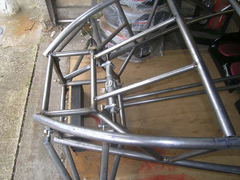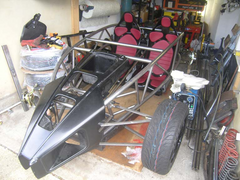
Round tube chassis
chrisg - 27/9/07 at 07:14 PM
Hey Up
Just a little question to exercise the grey matter.
The question is this.
Would a round tube chassis be a DIY proposition to the AVERAGE locost builder?
I've considered things like Tubemitre which is a good thing and those wizzo tube cutters Which are expensive, is there a cheap version?
cheers
Chris
MkIndy7 - 27/9/07 at 07:29 PM
Maybe a silly question, but what are the advantages of a round tube chassis?
For the lo-cost fitting of most body/interior/dash pannels etc surely its much easier to mount to and use square tubes.
Could a normal hole saw be used on a jig... not sure the blades would last long tho.
rayward - 27/9/07 at 07:32 PM
Ahhh brings visions of the Robin Hood 2B Chassis !!!!
anyway, tube notcher Here £150
Ray
smart51 - 27/9/07 at 07:33 PM
Cutting fish mouth ends on tubes may seem a lot of work over a square cut on a square tube but how many ends are cut square on a locost chassis? fish
mouths on round tubes butt up nicely with round tubes whatever the angle.
Round tubes are lighter than square and their lightness to stiffness ratio is better.
I guess that you could use a mixture of round and square where appropriate / easiest for fixing bodywork.
RichardK - 27/9/07 at 07:41 PM
I can't even cut box section straight 
Rich
nitram38 - 27/9/07 at 07:50 PM
Do you mean like this?


Description


Description
I have a brandnew notcher, but I found it easier to offer the tube up and mark it off and use a softpad/flap wheel on a hand grinder to do the
profiling.
It looks better in round but should also be stronger than the square equivalent, especially if it is rolled!
PS, Those 6 off 2 1/4" springs in the bottom photo are free to anyone who wants to collect them.
[Edited on 27/9/2007 by nitram38]
RichieW - 27/9/07 at 07:51 PM
Think round tubes would be too much for me. I've got no engineering background. I'm slowly building my locost chassis and the square tube at
least gives me points of reference with the four sides when cutting different angles at different ends of a tube. I dont know how I'd ever get
the rotation right and align the fishmouths at both ends of the same tube for cutting.
I reckon the average to poor builder like me would have trouble getting his head round it.
Square is so much easier to visualise.
chrisg - 27/9/07 at 07:54 PM
Looking good nitram mate!
The issues are the lightness/stiffness ratio but also the the project is "retro" and so the looks are important!
Thanks for the replies so far
Cheers
Chris
iank - 27/9/07 at 08:18 PM
Some info on rortys site
http://www.rorty-design.com/content/tube_work.htm
Canada EH! - 27/9/07 at 08:46 PM
The interesting part comes when it's time to fit the body panels, a lot more work to bend the panels around a pipe than a flat surface, a lot of
Locost builders have trouble with that back panel.
chrisg - 27/9/07 at 08:49 PM
Not a problem with my own project as the bodywork is all GRP or single curvature aluminium.
I'd agree for a Locost (or any seven, really) it would certainly add work.
cheers
Chris
Avoneer - 27/9/07 at 09:02 PM
And the man that wrote a book on building a chassis is asking us!
Chris - what can I say?
As a office junky and having built a chassis in square/round, I did find it a bit tricky and harder than square, especially fishmouthing with a
file.
Wouldn't recommend a full round chassis for a novice.
Harder to measure and set square as well.
Pat...
chrisg - 27/9/07 at 09:09 PM
quote:
Originally posted by Avoneer
And the man that wrote a book on building a chassis is asking us!
Chris - what can I say?
As a office junky and having built a chassis in square/round, I did find it a bit tricky and harder than square, especially fishmouthing with a
file.
Wouldn't recommend a full round chassis for a novice.
Harder to measure and set square as well.
Pat...
Thanks for the input Pat 
The chassis in the book is square tube of course, I'm just guaging opinion.
PERSONALLY I'd be able to make a round tube chassis in my tea break, obviously.
Cheers
Chris
PS how's your dental insurance?
Mark. - 27/9/07 at 09:12 PM
Flap disc in an angry grinder is best cheap way of profiling tubes...there is a nice way to make patterns so easier to repeat the tubes you need but
involves grp.
Mark
caber - 27/9/07 at 09:58 PM
You still need to do fishmouths for the wishbones and trailing arms. I used a pillar drill, hole saw ( a proper expensive starret one) and machine
vice bolted to the tilting table. It worked better than my attempts at jigging up some of the compound cuts on the square tube!
Caber
Mark. - 27/9/07 at 10:02 PM
Make a "wrap" in grp once you are happy with the profile...easy to repeat time and again. No need for expensive gear then just an angry
grinder with a flappy disc.
Mark
Minicooper - 27/9/07 at 10:11 PM
Here is a cheaper one
http://cgi.ebay.co.uk/Car-Frame-pipe-tube-notcher-tubing-notcher-cutter-NEW_W0QQitemZ140161262656QQcmdZViewItem?hash=item140161262656&_trksid=p328
6.c38.m63.l1177
$85 dollars shipping to UK makes it all together £75 they also do heavier duty ones as well.
I have the rollcentre version, it's well made and heavy duty and if you haven't used one, in about two minutes you will have a excellent
fishmouth ready to weld, it use to take ages using e a grinder and it's no where near as good
Cheers
David
worX - 27/9/07 at 10:22 PM
I'd do the same thing except instead of the machine vice I welded together two lots of - a piece of 2" angle onto a 2" flat and drilled
the flat so it fit the Pillar Drill bed bolt holes and then used the second one to rest on top of the piece of work so that it was clamped down if
necessary (ie when fishmouthing an ultra long piece of steel!)
Steve
quote:
Originally posted by caber
You still need to do fishmouths for the wishbones and trailing arms. I used a pillar drill, hole saw ( a proper expensive starret one) and machine
vice bolted to the tilting table. It worked better than my attempts at jigging up some of the compound cuts on the square tube!
Caber
I've just re-read that and it doesn't even make total sense to me, so I'll take a couple of photos if anyone needs me too!
Steve
[Edited on 27/9/07 by worX]
timf - 28/9/07 at 08:20 AM
or make your own tube notcher
Hammerhead - 28/9/07 at 09:31 AM
Flak Monkies website has a program that creates paper templates for fishmouths. Wrap it round the tube draw round the template and start cutting.
Tube notcher would be easier though.
smart51 - 28/9/07 at 10:07 AM
quote:
Originally posted by Hammerhead
Flak Monkies website has a program that creates paper templates for fishmouths. Wrap it round the tube draw round the template and start cutting.
Does it print onto masking tape?
Hammerhead - 28/9/07 at 11:05 AM
quote:
Originally posted by smart51
quote:
Originally posted by Hammerhead
Flak Monkies website has a program that creates paper templates for fishmouths. Wrap it round the tube draw round the template and start cutting.
Does it print onto masking tape?
could print onto sticky a4 stickers from Staples or other office suppliers.
nasty-bob - 29/9/07 at 07:59 PM
Whats wrong with a hacksaw and a half-round file. Doesn't take that long really.
But I guess I cheated- used a chopsaw and a half round.
Saw that someone asked why round is better than square. Round is better in torsion square better in bending. Really only the centreline of the chassis
is in true torsion and the sides are in mostly bending. There is a point somewhere in between where square becomes favourable over round.
But then that all changes depending on how your dampers are mounted.
Apologies if someone had beat me to it with the answer.
Oh... and round just looks much nicer.
Used a bit of both in mine.
link
[Edited on 29/9/07 by nasty-bob]
chrisg - 30/9/07 at 08:19 PM
That looks nice Bob!
I might have a go at building one of those DIY notchers.
Next question
Material?
mild steel or something more exotic?
Cheers
Chris
Mark. - 30/9/07 at 09:05 PM
4130
chrisg - 30/9/07 at 09:21 PM
Deciphering Marks long, rambling and comprehensive answer, I deduce that he favours the use of 4130 steel tubing or "cromolly" as it's
known.
Bit dear - is it absolutely neccesary?
What about gas pipe?
Cheers
Chris 
DIY Si - 30/9/07 at 10:32 PM
If you want really light, then 4130 is a good bet, but will lighten your wallet to a much higher degree! If you want to make it for less, would normal
seemed tube be ok, as it is with square, or would CDS or the like be better?
nasty-bob - 1/10/07 at 07:24 PM
T45 is superior to chromoly and does not require heat treating. It has a UTS of about 800MPa compared to about 400 for carbon steel.
But my reasoning tells me this is only an advantage on parts that might see a one time high loading- suspension and roll hoop. Here you can reduce
wall thickness and maintain safety factor.
With the chassis itself, it's loading is not one-off peaks but long term cyclic loading. So here we use the yeild strength of the material in
stress calculations, which is about 200MPa for all steels.
The extra money that would be spent on posh tube would, IMHO, be more wisely spent on lightweight products elsewhere.
I'd make it out of ERW and spend the saved cash on machining some nice uprights 
Cheers
Lippoman - 2/10/07 at 02:10 AM
A frame/chassis would most likely be designed on stiffness where the Elastic Modulus is the factor. This is around 200 GPa for steels.
The yield strengths for steels vary as much as the tensile strengths. (200-2000 MPa on grades I know)
Another factor to take into account is elongation, I'd like high elongation so the parts bend/stretch instead of "snapping" in part,
easier to spot a frame that is "about to fail"...








